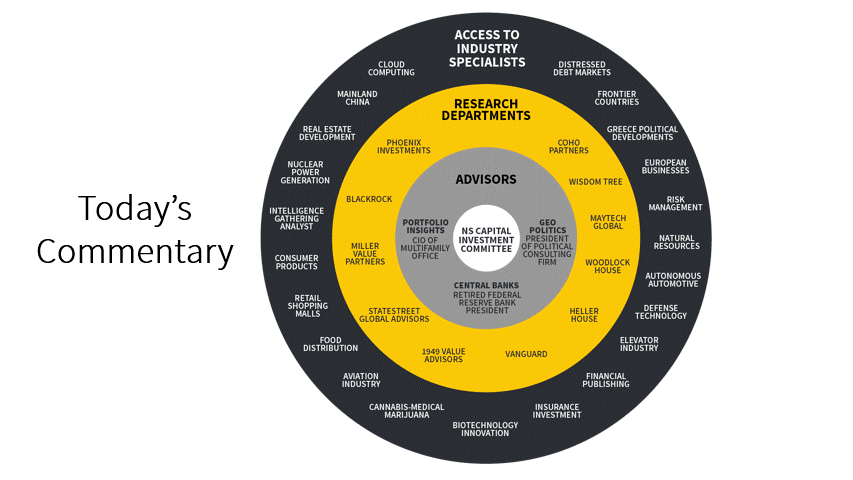NS Capital has created a research network that gives us access to one-on-one expertise on a global scale. Better Information = Better Decisions!

In an industry that over labels everything, the NS Capital Investment Committee believes there are only two investment categories: Established…or quickly establishing…leaders and too cheap to ignore. The first category is straightforward but the second requires a different perspective. Essentially “too cheap to ignore” is when most of the investing herd has become disinterested in an industry or set of companies. Think the “Clearance or Second-Hand Rack.” People that focus on “too cheap to ignore” are searching for the one diamond in a pile of damaged goods. Not an easy task in normal times but exponentially harder in the COVID-19 era. But, if done effectively, one can benefit from excellent return potential. As this perspective is a critical part of the Alpha Ring, we thought it would be interesting to get a firsthand account of this investment approach…with a focus on the last 12 months. Thankfully, we have an expert to provide that insight. That being Dan Lysik of Miller Value Partners. Dan has been an Alpha Ring manager-partner since May 2018, and we are fortunate to have him on our team. Below are key highlights from Todd Peters, Chair of our Investment Committee, conversation with Dan on March 1st.
What initially comes to mind as you think back over the past 12 months?
The past year was a bit of a roller coaster! The COVID-19 outbreak caused significant equity market volatility, 28 days during the year with moves of +/-3%, more than the previous 9 years combined and the most since 2008 (42 days). While the industry generally defines greater volatility as risk, we welcome the “dislocation”. We have found increased volatility tends to lead to the widening of price-value gaps and greater long-term return potential. Looking back over the past 20+ years, some of our best long-term investments started from one of these corrections.
So, March was a tremendous opportunity?
Yes, absolutely! We were watching as the market was penalizing companies well beyond a 12-month impact. They were acting as this was a permanent environment. The market seemed to be disregarding a company’s balance sheet. In many instances, companies we were following were trading below the liquidation values. This did not make any sense to us. We elected to play offense.
What were a couple of areas that drew your attention?
It is best to think of this as a search for opportunities in forgotten assets. Two that quickly come to mind is retail and oil. These industries were under pressure prior to the pandemic and were particularly punished as the early stages set in. It appeared that the market was assuming a large portion of these businesses as worthless. In retail, the market seemed to envision that 50% of pre-pandemic customers would simply never come back. And, in energy, the market seemed to imply that 50% of oil rigs would never comeback on-line…even if oil prices recovered. So, those industries were of high interest. Now, many companies in these segments rightly failed. The key is identifying those that will not only survive but have the potential to grow post-pandemic.
How do you have the confidence to search for those diamonds?
We have found that balance sheets, asset bases and free cash generation capabilities are incredibly important. In addition, companies with strengths in these areas affords the management teams the flexibility to adapt to a rapidly changing environment to maintain the enterprise’s fundamental value and, in some instances, take actions to create even greater long-term equity value.
Are conversations with company management critical?
Yes, very much so. It is the necessary piece to give us confidence in times of turmoil. We are looking for the smarter management teams that can quickly re-prioritize action plans. Our conversations focus on three key areas: 1) the balance sheet (how is the debt structured, what capital is readily available, and are there non-core assets that can be sold), 2) the cost structure (how can the company reduce near-term cash expenses to live through the downturn), and 3) the post-downturn positioning (ability to accelerate transition plans and enhance future revenue opportunities). Our understanding in these areas afford us the ability to buy more shares at tremendous prices.
Is the combination of defense and offense what you are looking for?
It is. We call it the multiplier effect. The goal is to protect the company’s value in times of stress while, at the same time, positioning the business for future growth. As the market becomes more comfortable in the company’s prospects, the stock price tends to appreciate meaningfully. An example would Bed, Bath & Beyond. This retailer used the pandemic to accelerate its ecommerce platform, which is showing much early promise. The market has rewarded this decision as the price stock has gone from a low of $3.56 per share (April 2, 2020) to $27.73 per share (March 2, 2021).
Concluding thoughts?
While we had a strong year in 2020, our current holdings valuation levels are still not far from their absolute historical lows. Collectively, the strategy is more than 50% below its 2-year high. Returning to normalized profitability and historical average valuation for our holdings over the next couple of years has the potential to generate meaningful returns. We are excited to see how 2021 unfolds.
